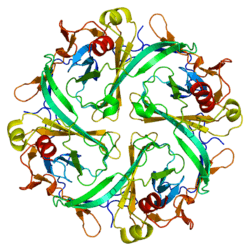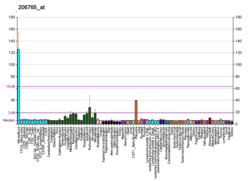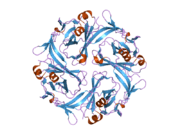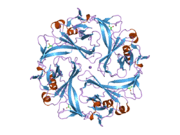Kir2.1
The Kir2.1 inward-rectifier potassium ion channel is a lipid-gated ion channel encoded by the KCNJ2 gene.[5][6][7][8]
Clinical significance
A defect in this gene is associated with Andersen-Tawil syndrome.[9]
A mutation in the KCNJ2 gene has also been shown to cause short QT syndrome.[10]
In research
In neurogenetics, Kir2.1 is used in Drosophila research to inhibit neurons, as overexpression of this channel will hyperpolarize cells.
In optogenetics, a trafficking sequence from Kir2.1 has been added to halorhodopsin to improve its membrane localization. The resulting protein eNpHR3.0 is used in optogenetic research to inhibit neurons with light.[11]
Expression of Kir2.1 gene in human HEK293 cells induce a transient outward current, creating a steady membrane potential close to the reversal potential of potassium.[12]
References
- GRCh38: Ensembl release 89: ENSG00000123700 - Ensembl, May 2017
- GRCm38: Ensembl release 89: ENSMUSG00000041695 - Ensembl, May 2017
- "Human PubMed Reference:". National Center for Biotechnology Information, U.S. National Library of Medicine.
- "Mouse PubMed Reference:". National Center for Biotechnology Information, U.S. National Library of Medicine.
- Hansen, SB (May 2015). "Lipid agonism: The PIP2 paradigm of ligand-gated ion channels". Biochimica et Biophysica Acta (BBA) - Molecular and Cell Biology of Lipids. 1851 (5): 620–8. doi:10.1016/j.bbalip.2015.01.011. PMC 4540326. PMID 25633344.
- Raab-Graham KF, Radeke CM, Vandenberg CA (1994). "Molecular cloning and expression of a human heart inward rectifier potassium channel". NeuroReport. 5 (18): 2501–5. doi:10.1097/00001756-199412000-00024. PMID 7696590.
- Derst C, Karschin C, Wischmeyer E, Hirsch JR, Preisig-Müller R, Rajan S, Engel H, Grzeschik K, Daut J, Karschin A (2001). "Genetic and functional linkage of Kir5.1 and Kir2.1 channel subunits". FEBS Lett. 491 (3): 305–11. doi:10.1016/S0014-5793(01)02202-5. PMID 11240146.
- Kubo Y, Adelman JP, Clapham DE, Jan LY, Karschin A, Kurachi Y, Lazdunski M, Nichols CG, Seino S, Vandenberg CA (2005). "International Union of Pharmacology. LIV. Nomenclature and molecular relationships of inwardly rectifying potassium channels". Pharmacol. Rev. 57 (4): 509–26. doi:10.1124/pr.57.4.11. PMID 16382105.
- Donaldson MR, Yoon G, Fu YH, Ptacek LJ (2004). "Andersen-Tawil syndrome: a model of clinical variability, pleiotropy, and genetic heterogeneity". Ann. Med. 36 Suppl 1: 92–7. doi:10.1080/17431380410032490. PMID 15176430.
- Priori SG, Pandit SV, Rivolta I, Berenfeld O, Ronchetti E, Dhamoon A, Napolitano C, Anumonwo J, di Barletta MR, Gudapakkam S, Bosi G, Stramba-Badiale M, Jalife J (April 2005). "A novel form of short QT syndrome (SQT3) is caused by a mutation in the KCNJ2 gene". Circ. Res. 96 (7): 800–7. doi:10.1161/01.RES.0000162101.76263.8c. PMID 15761194.
- Gradinaru V, Zhang F, Ramakrishnan C, Mattis J, Prakash R, Diester I, Goshen I, Thompson KR, Deisseroth K (April 2010). "Molecular and cellular approaches for diversifying and extending optogenetics". Cell. 141 (1): 154–65. doi:10.1016/j.cell.2010.02.037. PMC 4160532. PMID 20303157.
- Zhang, De-Yong; Lau, Chu-Pak; Li, Gui-Rong (2009-04-01). "Human Kir2.1 channel carries a transient outward potassium current with inward rectification". Pflügers Archiv: European Journal of Physiology. 457 (6): 1275–1285. doi:10.1007/s00424-008-0608-0. ISSN 1432-2013. PMID 19002489.
- Nehring RB, Wischmeyer E, Döring F, Veh RW, Sheng M, Karschin A (2000). "Neuronal inwardly rectifying K(+) channels differentially couple to PDZ proteins of the PSD-95/SAP90 family". J. Neurosci. 20 (1): 156–62. doi:10.1523/JNEUROSCI.20-01-00156.2000. PMC 6774109. PMID 10627592.
- Kurschner C, Yuzaki M (1999). "Neuronal interleukin-16 (NIL-16): a dual function PDZ domain protein". J. Neurosci. 19 (18): 7770–80. doi:10.1523/JNEUROSCI.19-18-07770.1999. PMC 6782450. PMID 10479680.
- Grishin A, Li H, Levitan ES, Zaks-Makhina E (2006). "Identification of gamma-aminobutyric acid receptor-interacting factor 1 (TRAK2) as a trafficking factor for the K+ channel Kir2.1". J. Biol. Chem. 281 (40): 30104–11. doi:10.1074/jbc.M602439200. PMID 16895905.
Further reading
- Kubo Y, Adelman JP, Clapham DE, et al. (2006). "International Union of Pharmacology. LIV. Nomenclature and molecular relationships of inwardly rectifying potassium channels". Pharmacol. Rev. 57 (4): 509–26. doi:10.1124/pr.57.4.11. PMID 16382105.
- Wood LS, Tsai TD, Lee KS, Vogeli G (1995). "Cloning and functional expression of a human gene, hIRK1, encoding the heart inward rectifier K+-channel". Gene. 163 (2): 313–7. doi:10.1016/0378-1119(95)00244-Z. PMID 7590287.
- Kubo Y, Baldwin TJ, Jan YN, Jan LY (1993). "Primary structure and functional expression of a mouse inward rectifier potassium channel". Nature. 362 (6416): 127–33. Bibcode:1993Natur.362..127K. doi:10.1038/362127a0. PMID 7680768.
- Raab-Graham KF, Radeke CM, Vandenberg CA (1995). "Molecular cloning and expression of a human heart inward rectifier potassium channel". NeuroReport. 5 (18): 2501–5. doi:10.1097/00001756-199412000-00024. PMID 7696590.
- Ashen MD, O'Rourke B, Kluge KA, et al. (1995). "Inward rectifier K+ channel from human heart and brain: cloning and stable expression in a human cell line". Am. J. Physiol. 268 (1 Pt 2): H506–11. doi:10.1152/ajpheart.1995.268.1.H506. PMID 7840300.
- Tang W, Qin CL, Yang XC (1996). "Cloning, localization, and functional expression of a human brain inward rectifier potassium channel (hIRK1)". Recept. Channels. 3 (3): 175–83. PMID 8821791.
- Tare M, Prestwich SA, Gordienko DV, et al. (1998). "Inwardly rectifying whole cell potassium current in human blood eosinophils". J. Physiol. 506 (2): 303–18. doi:10.1111/j.1469-7793.1998.303bw.x. PMC 2230727. PMID 9490857.
- Rae JL, Shepard AR (1998). "Inwardly rectifying potassium channels in lens epithelium are from the IRK1 (Kir 2.1) family". Exp. Eye Res. 66 (3): 347–59. doi:10.1006/exer.1997.0432. PMID 9533862.
- Kurschner C, Yuzaki M (1999). "Neuronal interleukin-16 (NIL-16): a dual function PDZ domain protein". J. Neurosci. 19 (18): 7770–80. doi:10.1523/JNEUROSCI.19-18-07770.1999. PMC 6782450. PMID 10479680.
- Tucker SJ, Ashcroft FM (1999). "Mapping of the physical interaction between the intracellular domains of an inwardly rectifying potassium channel, Kir6.2". J. Biol. Chem. 274 (47): 33393–7. doi:10.1074/jbc.274.47.33393. PMID 10559219.
- Nehring RB, Wischmeyer E, Döring F, et al. (2000). "Neuronal inwardly rectifying K(+) channels differentially couple to PDZ proteins of the PSD-95/SAP90 family". J. Neurosci. 20 (1): 156–62. doi:10.1523/JNEUROSCI.20-01-00156.2000. PMC 6774109. PMID 10627592.
- Leonoudakis D, Mailliard W, Wingerd K, et al. (2001). "Inward rectifier potassium channel Kir2.2 is associated with synapse-associated protein SAP97". J. Cell Sci. 114 (Pt 5): 987–98. PMID 11181181.
- Derst C, Karschin C, Wischmeyer E, et al. (2001). "Genetic and functional linkage of Kir5.1 and Kir2.1 channel subunits". FEBS Lett. 491 (3): 305–11. doi:10.1016/S0014-5793(01)02202-5. PMID 11240146.
- Stockklausner C, Ludwig J, Ruppersberg JP, Klöcker N (2001). "A sequence motif responsible for ER export and surface expression of Kir2.0 inward rectifier K(+) channels". FEBS Lett. 493 (2–3): 129–33. doi:10.1016/S0014-5793(01)02286-4. PMID 11287009.
- Dart C, Leyland ML (2001). "Targeting of an A kinase-anchoring protein, AKAP79, to an inwardly rectifying potassium channel, Kir2.1". J. Biol. Chem. 276 (23): 20499–505. doi:10.1074/jbc.M101425200. PMID 11287423.
- Plaster NM, Tawil R, Tristani-Firouzi M, et al. (2001). "Mutations in Kir2.1 cause the developmental and episodic electrical phenotypes of Andersen's syndrome". Cell. 105 (4): 511–9. doi:10.1016/S0092-8674(01)00342-7. PMID 11371347.
- Jeong JS, Lee HJ, Jung JS, et al. (2001). "Characterization of inwardly rectifying K(+) conductance across the basolateral membrane of rat tracheal epithelia". Biochem. Biophys. Res. Commun. 288 (4): 914–20. doi:10.1006/bbrc.2001.5831. PMID 11688996.
- Giovannardi S, Forlani G, Balestrini M, et al. (2002). "Modulation of the inward rectifier potassium channel IRK1 by the Ras signaling pathway". J. Biol. Chem. 277 (14): 12158–63. doi:10.1074/jbc.M110466200. PMID 11809752.
- Preisig-Müller R, Schlichthörl G, Goerge T, et al. (2002). "Heteromerization of Kir2.x potassium channels contributes to the phenotype of Andersen's syndrome". Proc. Natl. Acad. Sci. U.S.A. 99 (11): 7774–9. Bibcode:2002PNAS...99.7774P. doi:10.1073/pnas.102609499. PMC 124349. PMID 12032359.
- Ai T, Fujiwara Y, Tsuji K, et al. (2002). "Novel KCNJ2 mutation in familial periodic paralysis with ventricular dysrhythmia". Circulation. 105 (22): 2592–4. doi:10.1161/01.CIR.0000019906.35135.A3. PMID 12045162.
External links
- GeneReviews/NCBI/NIH/UW entry on Andersen-Tawil syndrome
- OMIM entries on Anderson-Tawil syndrome
- KCNJ2+protein,+human at the US National Library of Medicine Medical Subject Headings (MeSH)
- Kir2.1+channel at the US National Library of Medicine Medical Subject Headings (MeSH)







